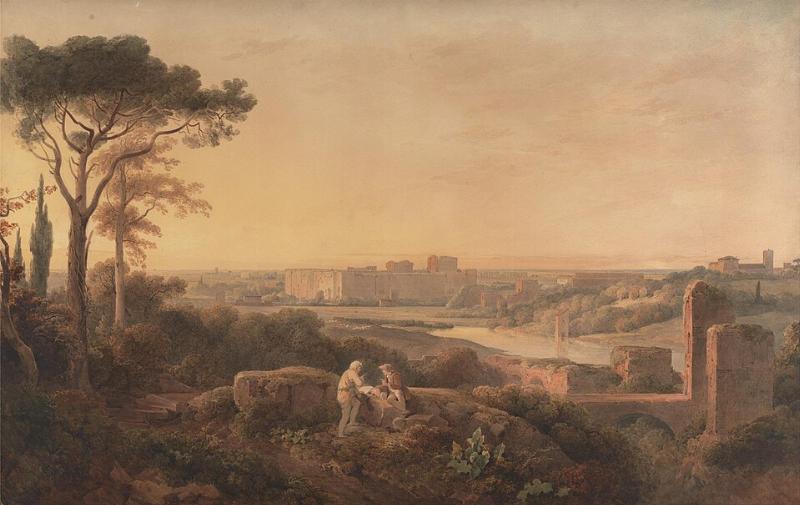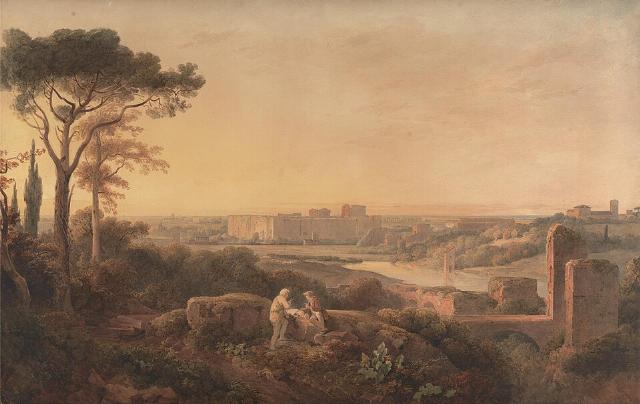



From Wikipedia Commons: The Baths of Caracalla (Andrew Wilson, 1810)
Euston Station, opening in 1837, was the first inter-city railway station in London. It embodied the grandeur of the railway age, with the monumental Euston Arch acting as a neoclassical gateway to the north. Its demolition in 1962 to replace it with a modernist building has been widely condemned as a cultural tragedy, motivated by bureaucratic expedience rather than architectural necessity.
America has its own tragedy to tell. In an era, when steel and ambition reshaped the skyline, Pennsylvania Station asserted itself as an incomparable example of civic art. Completed in 1910 by the architectural firm McKim, Mead & White, it was a triumph of Beaux-Arts design — an architectural philosophy holding that grandeur should be accessible to all. Modeled after the Baths of Caracalla in ancient Rome, Penn Station rose above a mere terminal; it was a democratic palace, a monument to the public, inviting ordinary people to move through vast halls and beneath coffered ceilings once reserved for emperors. A tribute to classical beauty, the edifice was intended as a shared experience.
The design of Penn Station made a bold cultural statement: that a train station — a space of routine comings and goings — could be worthy of reverence. As travelers stepped off trains from Philadelphia, Chicago, or St. Louis, they emerged into a city that announced its importance through space, light, and symmetry. The breathtaking experience transcended the functional; it was spiritual in nature.
The vast main waiting room, modeled on Roman baths, was flooded with light from soaring skylights 150 feet above. The main concourse, with its steel-trussed arches and glass ceiling, blurred the line between basilica and machine. It was the embodiment of, what the architectural historian Lewis Mumford once called “the drama of democracy”, where public space was noble, intentional, and affirming.
By the mid-20th century, the ideals giving birth to Penn Station had eroded. The rise of the automobile, the construction of the interstate highway system, and the allure of air travel diminished the centrality of railroads. The Pennsylvania Railroad, once the largest corporation in the world, entered financial decline. The shift in experience — from transcendental to transactional — captures the broader story of America’s postwar cities: a retreat from the public realm, a surrender to the car, and a dismissal of beauty as elitist or impractical.
Facing insolvency, the railroad sold the air rights above the station to developers. The plan was radical: demolish the monumental station, bury the train tracks underground, and construct Madison Square Garden, two office towers, and a shopping concourse in its place. The decision, couched in the language of economic adventurism, was a disastrous case of cultural amnesia. It demonstrated a willingness to sacrifice beauty for profitability — and to treat irreplaceable heritage as expendable.
Upsetting to watch up close, demolition began in October 1963, continuing into 1966. Enormous Corinthian columns were jackhammered, bronze eagles discarded, skylights shattered, and stone archways hauled away. Much of the granite and marble was dumped unceremoniously in the Meadowlands of New Jersey. (Incidentally, Euston Arch fragments remain as fill in the Prescott Channel.)
What replaced Penn Station was uninspired and cannibalistic-sacrificing. The new station, buried beneath Madison Square Garden (designed by Charles Luckman), became a claustrophobic warren of corridors, low ceilings, and flickering lights. Where once there had been columns and sunlight, there were now concrete walls and flickering signage. The station became a space of anxiety, unfit for the millions who passed through it. It was, in the words of architecture critic Michael Kimmelman, “a dungeon unworthy of a city that calls itself great.”
The aesthetic insult was psychological by implication. The grandeur of the old station affirmed your importance; the new one blankly denied it. The architectural theorist Juhani Pallasmaa has argued that architecture must engage the senses — it must dignify the body’s movement through space. Penn Station did the opposite: it diminished, disoriented, and degraded. It became an emblem not only of poor design, but of urban failure. Vincent Scully’s iconic lament still echoes: “One entered the city like a god; one scuttles in now like a rat.”
Yet in its death, leaving a terrible void, Penn Station provided the impetus for preservation initiatives. The public backlash sparked by its demolition galvanized beauty-loving citizens. In 1965, New York established the Landmarks Preservation Commission. This agency would go on to save dozens of valuable buildings, including Grand Central Terminal, which narrowly escaped a similar fate in the 1970s.
Although tragic, the fate of Penn Station marks partly the end of a story and partly the beginning of a historical consciousness. Citizens came to understand that the built environment is thoroughly symbol-laden. Buildings are cultural artifacts; they shape memory, behavior, and identity. And once they are lost, they cannot be replaced with glass and steel alone.
The death of Penn Station went far beyond the destruction of a building. It was the erasure of memory, an act of cultural severance and civilizational self-cannibalism. The station represented continuity with classical ideals, civic pride, and another age when infrastructure was art. Its replacement signaled a new paradigm, with meaning being trumped by utility, subjecting civic spaces to the logic of short-term capital.
Urban theorist Jane Jacobs, reflecting on current trends, warned of the dangers of cities designed by “abstract metrics” rather than “lived experience”. Penn Station’s demolition is a case in point: a place designed to welcome people now merely “processes” them. It lacks the human scale, emotional resonance, and spatial dignity that make cities feel alive. Accordingly, commuters rush through Penn Station with their heads down. Nobody lingers. Nobody remembers.
And yet, the ghost of Penn Station has never truly left. It haunts books, documentaries, and political debates. It lives in the bronze eagles salvaged and scattered across the Northeast. It survives in Moynihan Train Hall, the long-awaited expansion completed in 2021 within the former James A. Farley Post Office building — itself designed by McKim, Mead & White. Moynihan is bright and spacious, echoing some of the lost station’s grandeur. However, it is only a partial redemption. The heart of Penn remains broken, buried beneath a basketball arena.
Recent proposals to relocate Madison Square Garden and build a new, “world-class” station above the tracks have gained momentum, backed by urban planners, civic leaders, and public advocacy groups. Unable to restore the lost beauty, architectural projects are nevertheless construed as efforts at cultural repair. Interestingly, they ask whether New York is willing to reclaim its place as a city that builds with boldness, vision, and respect for its own history.
Potentially, the story of Penn Station could be a lesson in loss, awakening, and possibility. It is a reminder that sublimity is never guaranteed — it must be cultivated, protected, and sometimes fought for. The old station was destroyed by developers. However, the public was complicit in the vandalism, having ceased to believe in grandeur and beauty.
However, the memory lingers. In a time when cities around the world confront similar choices — between preservation and progress, commerce and culture, speed and meaning — Penn Station remains a powerful symbol. It reminds us that architecture is not merely functional. It is emotional, political, and moral. It tells us who we are and what we value.
Outrage at civilization’s self-cannibalistic demolition of beloved railway stations in London and New York anticipated a broader public disillusionment with modernist architecture. While eager to promise functionality, efficiency, and honesty in materials, modernism ultimately delivered buildings perceived as inhospitable, austere, and alienating. The architectural replacements lacked the symbolic power and human scale of their predecessors, contributing to feelings of urban alienation and cultural dislocation. In a truly revolutionary spirit, the 1960s urban renewal agenda treated cities as blank slates — contemptuous of the time-proven and beautiful.
Unfortunately, we cannot bring Penn Station back in stone. In a better world, however, learning from our mistakes, we could revive the spirit that built it — a belief in public dignity, urban beauty, and the moral responsibility of cities to inspire their citizens. Vindicating the spirit of the old masters should not be confounded with nostalgia. Rather, building properly would be a return to our highest civic self.
“Any city gets what it admires, will pay for, and, ultimately, deserves. Even when we had Penn Station, we couldn’t afford to keep it clean. We want and deserve tin-can architecture in a tinhorn culture. And we will probably be judged not by the monuments we build but by those we have destroyed.” — New York Times, October 30, 1963.
